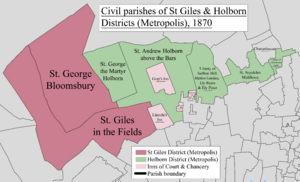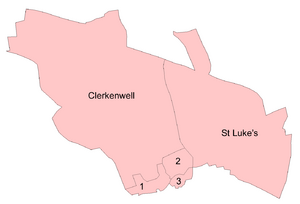Glasshouse Yard facts for kids
| Glasshouse Yard | |
 |
|
| Geography | |
| Status | Civil parish, liberty, extra-parochial area |
| 1801–1911 area | 5.6 acres (0.023 km2) |
| History | |
| Created | Seventeenth century |
| Abolished | 1915 |
| Succeeded by | Finsbury |
Quick facts for kids Demography |
|
|---|---|
| 1801 population | 1,221 |
| 1841 population | 1,415 |
| 1881 population | 931 |
| 1911 population | 463 |
The Liberty of Glasshouse Yard was a special area next to the City of London. It was called a "liberty" because it had its own rules and was separate from the main church parish. The name "Glasshouse Yard" came from a factory that made glass there. Today, this area is part of the London Borough of Islington.
Contents
How Glasshouse Yard Started
This area was once part of a larger church district called St Botolph without Aldersgate. Most of that district was inside the old City of London. But Glasshouse Yard was a northern part, located in the nearby county of Middlesex.
Over time, more and more people moved into this part of London. By the 1700s, it had become a busy city area. In 1601, a law called the "Act for the Relief of the Poor" was introduced. This law made each area responsible for helping its poor. Because of this, Glasshouse Yard set up its own local government, run by a group of trustees.
The Glass Factory Story
The name "Glasshouse Yard" comes from a glass-making factory that was built there around 1601. This was during the time of Queen Elizabeth I. Her government wanted to encourage new industries. They often allowed these new businesses to avoid certain taxes.
Factories that had a high risk of fire, like glassworks, were not allowed inside the City of London. So, they were built just outside the city walls. By 1661, the factory in Glasshouse Yard was making special crystal glass. However, by 1700, it seems the factory stopped making glass.
Where Glasshouse Yard Was Located
The Liberty of Glasshouse Yard had clear borders. To the south, it was next to the City of London. To the west, it bordered the parish of St Sepulchre. To the northeast, it was next to the Liberty of Charterhouse. And to the north and northwest, it bordered the parish of St Luke's.
The area was quite small, about 5.6 acres. By the 1800s, busy streets like Goswell Street (now the A1 road) and Pickaxe Street ran through it.
How Glasshouse Yard Was Governed
Local Divisions and Taxes
Glasshouse Yard was part of a larger area called Ossulstone Hundred. A "hundred" was an old way of dividing land in England, mainly for collecting taxes. Ossulstone was the hundred closest to London and grew a lot in population. By the 1600s, these hundreds were further divided. Glasshouse Yard became part of the Finsbury Division.
Helping the Poor
Glasshouse Yard managed its own system for helping the poor, separate from the main St Botolph parish. By the early 1700s, the main official in charge was called the "headborough."
In 1834, a new law called the "Poor Law Amendment Act" allowed different areas to join together to form "Poor Law Unions." These unions would share one large workhouse for people who needed help. In 1837, Glasshouse Yard joined the East London Poor Law Union. This union included several other parishes from the City of London. They built a workhouse in Homerton in 1852.
In 1866, Glasshouse Yard officially became its own separate civil parish. This meant it was a distinct area for local government purposes. Later, in 1869, the East London Poor Law Union merged with others to form the City of London Poor Law Union. In 1901, Glasshouse Yard moved to the Holborn Poor Law Union.
Holborn District Board
In 1855, the Metropolis Management Act 1855 created new local government bodies for London. These included "District Boards." The Holborn District Board of Works covered five parishes, and Glasshouse Yard was one of them. It had one representative on this board. These boards helped manage local services like roads and sewers.
In 1889, the area became the County of London, and the London County Council took over bigger projects. The district board continued for another eleven years.
Becoming Part of Finsbury
In 1899, the London Government Act 1899 changed London's local government again. It created 28 new "metropolitan boroughs." On November 1, 1900, Glasshouse Yard became part of the Metropolitan Borough of Finsbury. This new borough also included other areas like Charterhouse and Clerkenwell.
Glasshouse Yard officially stopped being a separate area in 1915. At that time, all the smaller parishes within the Borough of Finsbury were combined into one single parish called Finsbury.
Glasshouse Yard Today
The area where Glasshouse Yard once stood has changed a lot, especially after the Second World War. A modern street named Glasshouse Yard now exists to the west of Goswell Road, next to the Golden Lane Estate.


